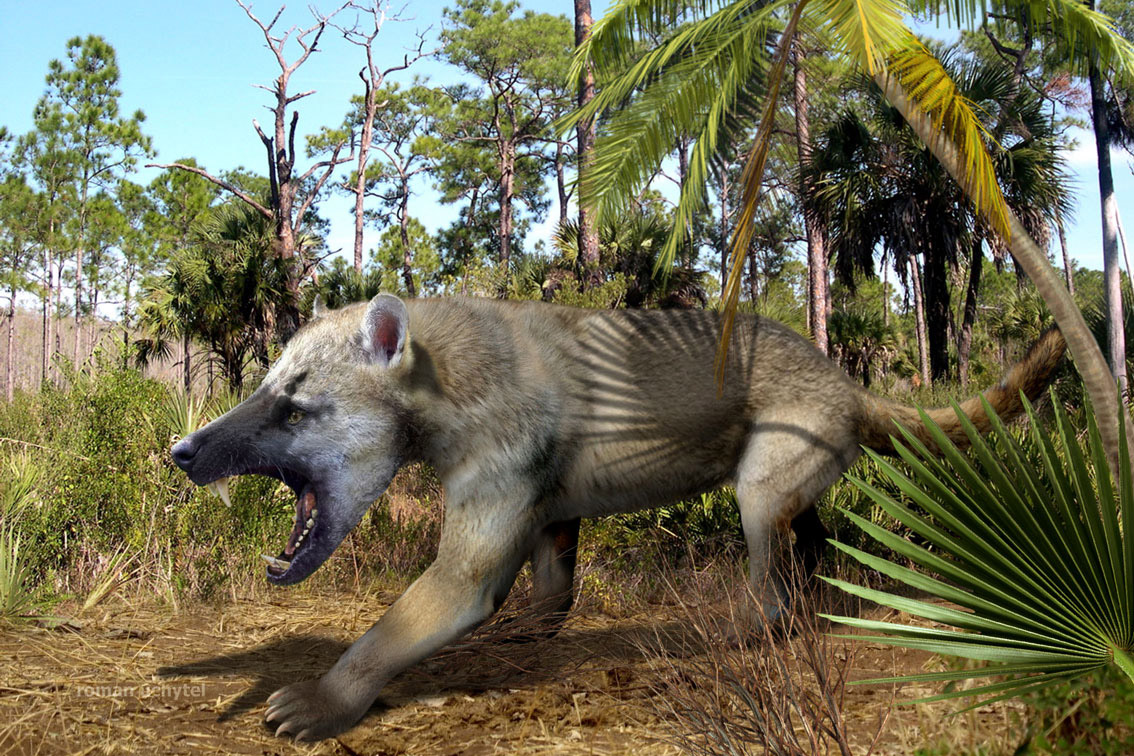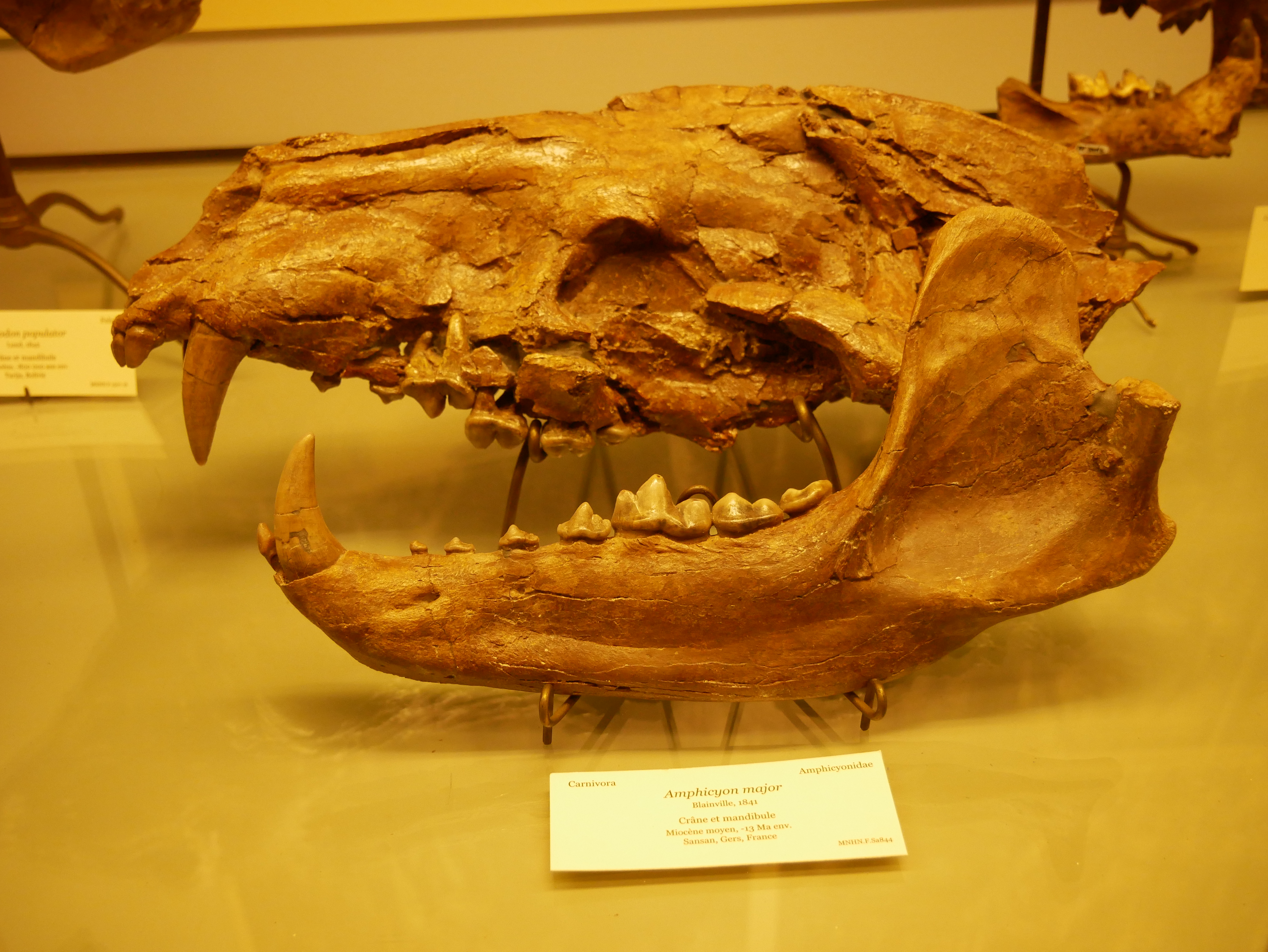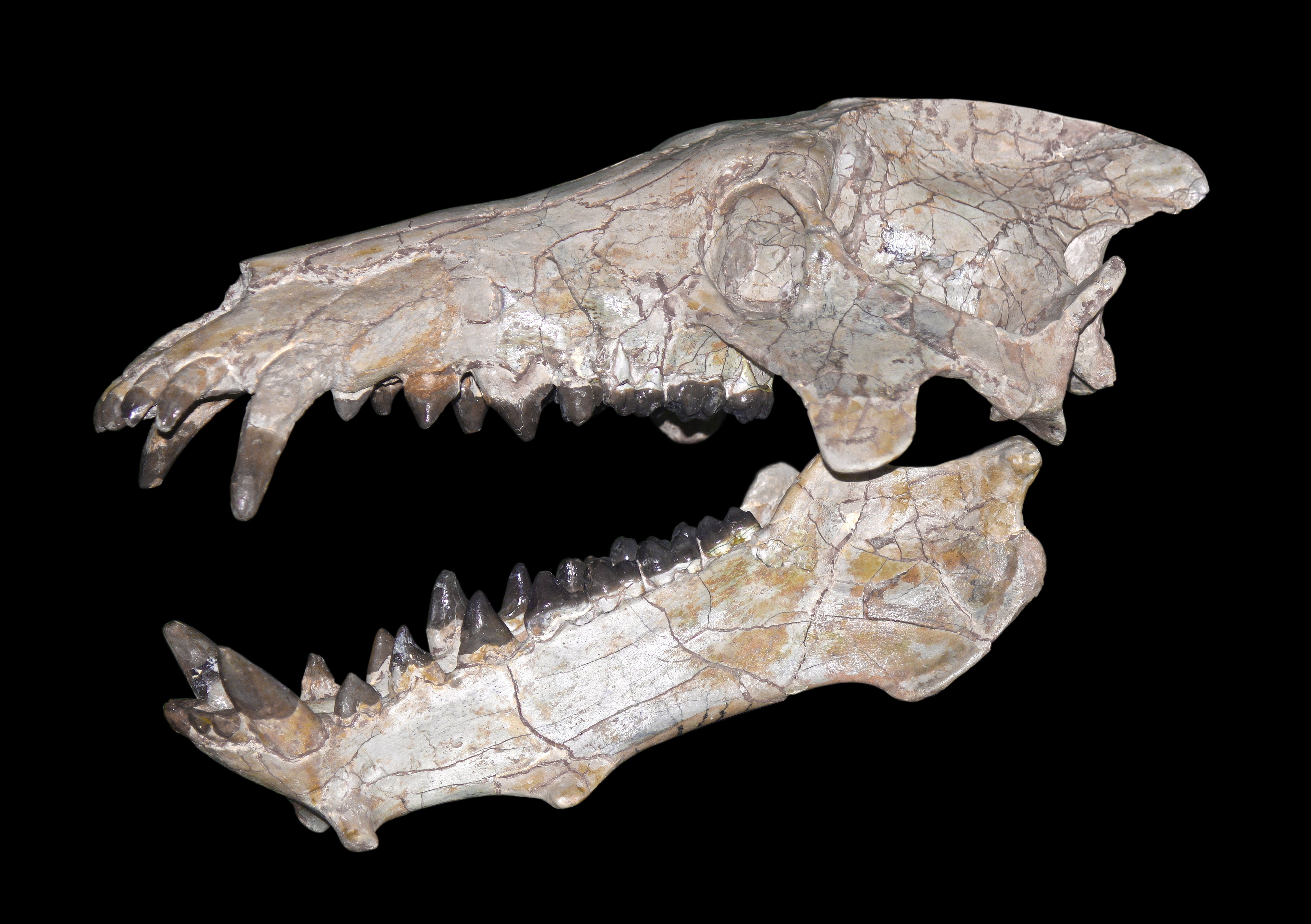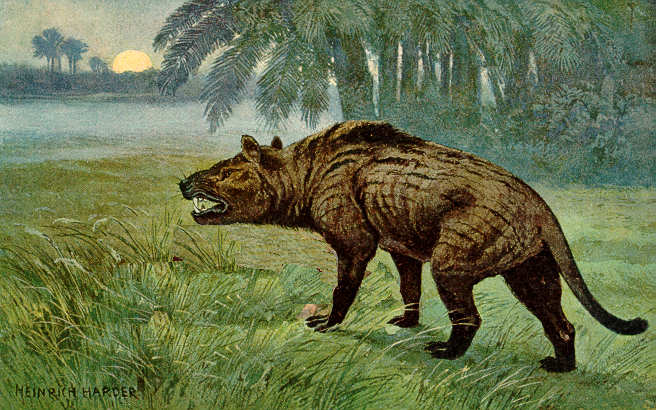|
Early Miocene
The Early Miocene (also known as Lower Miocene) is a sub-epoch of the Miocene epoch (geology), Epoch made up of two faunal stage, stages: the Aquitanian age, Aquitanian and Burdigalian stages. The sub-epoch lasted from 23.03 ± 0.05 annum, Ma to 15.97 ± 0.05 Ma (million years ago). It was preceded by the Oligocene epoch. As the climate started to get cooler, the landscape started to change. New mammals evolved to replace the extinct animals of the Oligocene epoch. The first members of the hyena and weasel family started to evolve to replace the extinct ''Hyaenodon'', entelodonts and bear-dogs. The chalicotheres survived the Oligocene epoch. A new genus of entelodont called ''Daeodon'' evolved in order to adapt to the new habitats and hunt the new prey animals of the Early Miocene epoch; it quickly became the top predator of North America. But it became extinct due to competition from ''Amphicyon'', a newcomer from Eurasia. ''Amphicyon'' bested ''Daeodon'' because the bear-dog's la ... [...More Info...] [...Related Items...] OR: [Wikipedia] [Google] [Baidu] |
Miocene
The Miocene ( ) is the first epoch (geology), geological epoch of the Neogene Period and extends from about (Ma). The Miocene was named by Scottish geologist Charles Lyell; the name comes from the Greek words (', "less") and (', "new") and means "less recent" because it has 18% fewer modern marine invertebrates than the Pliocene has. The Miocene followed the Oligocene and preceded the Pliocene. As Earth went from the Oligocene through the Miocene and into the Pliocene, the climate slowly cooled towards a series of ice ages. The Miocene boundaries are not marked by distinct global events but by regionally defined transitions from the warmer Oligocene to the cooler Pliocene Epoch. During the Early Miocene, Afro-Arabia collided with Eurasia, severing the connection between the Mediterranean and Indian Oceans, and allowing the interchange of fauna between Eurasia and Africa, including the dispersal of proboscideans and Ape, hominoids into Eurasia. During the late Miocene, the conn ... [...More Info...] [...Related Items...] OR: [Wikipedia] [Google] [Baidu] |
Bear-dogs
Amphicyonidae is an extinct Family (biology), family of Terrestrial animal, terrestrial carnivorans belonging to the suborder Caniformia. They first appeared in North America in the middle Eocene (around 45 mya), spread to Europe by the late Eocene (35 mya), and further spread to Asia and Africa by the early Miocene (23 mya). They had largely disappeared worldwide by the late Miocene (5 mya), with the latest recorded species at the end of the Miocene in Africa. They were among the first carnivorans to evolve large body size. Amphicyonids are colloquially referred to as "bear-dogs". Taxonomy The family was erected by Haeckel in 1866 (also attributed to Trouessart 1885). Their exact position has long been disputed. Early paleontologists usually defined them as members of Canidae (the dog family) or Bear, Ursidae (the bear family), but the modern consensus is that they form their own family. Some researchers have defined it as the sister clade to ursids, based on morphological anal ... [...More Info...] [...Related Items...] OR: [Wikipedia] [Google] [Baidu] |
Bear-dog
Amphicyonidae is an extinct family of terrestrial carnivorans belonging to the suborder Caniformia. They first appeared in North America in the middle Eocene (around 45 mya), spread to Europe by the late Eocene (35 mya), and further spread to Asia and Africa by the early Miocene (23 mya). They had largely disappeared worldwide by the late Miocene (5 mya), with the latest recorded species at the end of the Miocene in Africa. They were among the first carnivorans to evolve large body size. Amphicyonids are colloquially referred to as "bear-dogs". Taxonomy The family was erected by Haeckel in 1866 (also attributed to Trouessart 1885). Their exact position has long been disputed. Early paleontologists usually defined them as members of Canidae (the dog family) or Ursidae (the bear family), but the modern consensus is that they form their own family. Some researchers have defined it as the sister clade to ursids, based on morphological analysis of the ear region. However, cladistic ... [...More Info...] [...Related Items...] OR: [Wikipedia] [Google] [Baidu] |
Eurasia
Eurasia ( , ) is a continental area on Earth, comprising all of Europe and Asia. According to some geographers, Physical geography, physiographically, Eurasia is a single supercontinent. The concept of Europe and Asia as distinct continents dates back to classical antiquity, antiquity, but their borders have historically been subject to change. For example, the ancient Greeks originally included Africa in Asia but classified Europe as separate land. Eurasia is connected to Africa at the Suez Canal, and the two are sometimes combined to describe the largest contiguous landmass on Earth, Afro-Eurasia. History Eurasia has been the host of many ancient civilizations, including those based in Mesopotamia, Egypt, the Indus Valley and China. In the Axial Age (mid-first millennium BCE), a continuous belt of civilizations stretched through the Eurasian Subtropics, subtropical zone from the Atlantic to the Pacific. This belt became the mainstream of world history for two millennia. ... [...More Info...] [...Related Items...] OR: [Wikipedia] [Google] [Baidu] |
Amphicyon
''Amphicyon'' is an extinct genus of large carnivorans belonging to the family Amphicyonidae (known colloquially as "bear-dogs"), subfamily Amphicyoninae, from the Miocene epoch. Members of this family received their vernacular name for possessing bear-like and dog-like features. They ranged over North America, Eurasia, and Africa. Taxonomy In a note dated back to May 16, 1836, French geologist Alexandre Leymerie wrote a letter in April that he requested from French palaeontologist Édouard Lartet, which provided details of his exploits in palaeontological sites in the French department of Gers, in particular the commune Sansan. Lartet described his finds of fossil taxons that he found within the sites, including "'' Mastodonte''" (species assigned to it were later reclassified to another mammutid '' Zygolophodon'' and the gomphothere ''Gomphotherium''), "''Dinotherium''" (its species eventually reclassified as either ''Deinotherium'' or ''Prodeinotherium''), "''Rhinoceros' ... [...More Info...] [...Related Items...] OR: [Wikipedia] [Google] [Baidu] |
Competition
Competition is a rivalry where two or more parties strive for a common goal which cannot be shared: where one's gain is the other's loss (an example of which is a zero-sum game). Competition can arise between entities such as organisms, individuals, economic and social groups, etc. The rivalry can be over attainment of any exclusive goal, including recognition. Competition occurs in nature, between living organisms which co-exist in the same environment. Animals compete over water supplies, food, mates, and other biological resources. Humans usually compete for food and mates, though when these needs are met deep rivalries often arise over the pursuit of wealth, power, prestige, and fame when in a static, repetitive, or unchanging environment. Competition is a major tenet of market economies and business, often associated with business competition as companies are in competition with at least one other firm over the same group of customers. Competition inside a compan ... [...More Info...] [...Related Items...] OR: [Wikipedia] [Google] [Baidu] |
North America
North America is a continent in the Northern Hemisphere, Northern and Western Hemisphere, Western hemispheres. North America is bordered to the north by the Arctic Ocean, to the east by the Atlantic Ocean, to the southeast by South America and the Caribbean Sea, and to the south and west by the Pacific Ocean. The region includes Middle America (Americas), Middle America (comprising the Caribbean, Central America, and Mexico) and Northern America. North America covers an area of about , representing approximately 16.5% of Earth's land area and 4.8% of its total surface area. It is the third-largest continent by size after Asia and Africa, and the list of continents and continental subregions by population, fourth-largest continent by population after Asia, Africa, and Europe. , North America's population was estimated as over 592 million people in list of sovereign states and dependent territories in North America, 23 independent states, or about 7.5% of the world's popula ... [...More Info...] [...Related Items...] OR: [Wikipedia] [Google] [Baidu] |
Daeodon
''Daeodon'' is an extinct genus of entelodont even-toed ungulates that inhabited North America about 29 to 15.97 million years ago from the early Oligocene to late early Miocene. The type species is ''Daeodon shoshonensis'', described from a very fragmentary holotype by Cope. Some authors synonymize it with ''Dinohyus hollandi'' and several other species (see below), but due to the lack of diagnostic material, this may be questionable. Another large member of this family, possibly larger than ''Daeodon'', is the Asian ''Paraentelodon,'' but it is known by very incomplete material. Taxonomy The genus ''Daeodon'' was erected by the American anatomist and paleontologist Edward Drinker Cope in 1878. He classified it as a perissodactyl and thought that it was closely related to ''Menodus''. This classification persisted until the description of ''"Entelodon, Elotherium" calkinsi'' in 1905, a very similar and much more complete animal from the same rocks, which was promptly assign ... [...More Info...] [...Related Items...] OR: [Wikipedia] [Google] [Baidu] |
Chalicothere
Chalicotheriidae (from Ancient Greek ''khálix'', "gravel", and ''theríon'', "beast") is an extinct family of herbivorous, odd-toed ungulate (perissodactyl) mammals that lived in North America, Eurasia, and Africa from the Middle Eocene to the Early Pleistocene. They are often called chalicotheres, a term which is also applied to the broader grouping of Chalicotherioidea. They are noted for their unusual morphology compared to other ungulates, such as their clawed forelimbs. Members of the subfamily Chalicotheriinae developed elongate gorilla-like forelimbs that are thought to have been used to grasp vegetation. They are thought to have been browsers on foliage as well as possibly bark and fruit. History of discovery The first chalicotheres remains discovered were ungual phalanges found near Eppelsheim, Germany in the early 19th century. These remains were considered to belong to gigantic pangolins by Georges Cuvier in 1822 while Johann Jakob Kaup in 1833 alternatively a ... [...More Info...] [...Related Items...] OR: [Wikipedia] [Google] [Baidu] |
Entelodont
Entelodontidae is an extinct family of pig-like artiodactyls (even-toed ungulates) which inhabited the Northern Hemisphere (Asia, Europe, and North America) from the late Eocene to the early Miocene epochs, about 38-19 million years ago. Their large heads, low snouts, narrow gait, and proposed omnivorous diet inspires comparisons to suids (true pigs) and tayassuids (peccaries), and historically they have been considered closely related to these families purely on a morphological basis. However, studies which combine morphological and molecular (genetic) data on artiodactyls instead suggest that entelodonts are cetancodontamorphs, more closely related to hippos and cetaceans through their resemblance to ''Pakicetus'', than to basal pigs like '' Kubanochoerus'' and other ungulates. Description Entelodonts could get quite large, and in many cases are the largest mammals in their respective ecosystems. The largest entelodont known from a complete skeleton was '' Daeodon'', a No ... [...More Info...] [...Related Items...] OR: [Wikipedia] [Google] [Baidu] |
Epoch (geology)
The geologic time scale or geological time scale (GTS) is a representation of time based on the rock record of Earth. It is a system of chronological dating that uses chronostratigraphy (the process of relating strata to time) and geochronology (a scientific branch of geology that aims to determine the age of rocks). It is used primarily by Earth scientists (including geologists, paleontologists, geophysicists, geochemists, and paleoclimatologists) to describe the timing and relationships of events in geologic history. The time scale has been developed through the study of rock layers and the observation of their relationships and identifying features such as lithologies, paleomagnetic properties, and fossils. The definition of standardised international units of geological time is the responsibility of the International Commission on Stratigraphy (ICS), a constituent body of the International Union of Geological Sciences (IUGS), whose primary objective is to precis ... [...More Info...] [...Related Items...] OR: [Wikipedia] [Google] [Baidu] |
Hyaenodon
''Hyaenodon'' ("hyena-tooth") is an Extinction (biology), extinct genus of Carnivore, carnivorous Placentalia, placental mammals from extinct tribe Hyaenodontini within extinct subfamily Hyaenodontinae (in extinct Family (biology), family Hyaenodontidae),Malcolm C. McKenna, Susan K. Bell (1997)"Classification of Mammals: Above the Species Level" Columbia University Press, New York, 631 pages. that lived in Eurasia and North America from the early Eocene to the early Miocene. Classification and phylogeny Taxonomy Description The skull of ''Hyaenodon'' was long with a narrow snout—much larger in relation to the length of the skull than in Canidae, canine carnivores, for instance. The neck was shorter than the skull, while the body was long and robust and terminated in a long tail. Compared to the larger (but not closely related) ''Hyainailouros'', the dentition of ''Hyaenodon'' was geared more towards shearing meat and less towards bone crushing. Some species of this ... [...More Info...] [...Related Items...] OR: [Wikipedia] [Google] [Baidu] |









